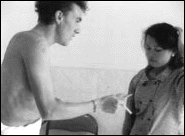|
|
| Director, Photography: Dy Sethi Editing: Sylvie Gadmer Sound: Sam Maly Production Company, Source: ATELIERS VARAN 6, Impasse Mont-Louis, 75011 Paris FRANCE Phone:33-1-43 56 64 04 / Fax: 33-1-43 56 29 02 CAMBODIA / 1995 / Khmer / Color / Video / 24 min |
27 years old. Student at the Royal University of Fine Arts of Cambodia. Works in the Department of Cinema and Video Management at the Ministry of Cambodian Culture and Fine Arts. Completed training courses at the "Ateliers Varan" studios from November '94 to December '95. He is also a playwright. |
 |
|
|
In collaboration with the French government, Ateliers Varan has been conducting documentary workshops in countries around the world to help people explore and express what cultural identity means through the use of images and sound. These four videos were shot on Hi-8 video and were completed in 1994-5. They attest to the realities and strengths of the people of Cambodia. In Ary Left For the City, a country girl leaves her village for a life as a "taxi-girl" in the city. She goes out with foreigners, dances with men in nightclubs, and makes good money. ILeft the War features a deserter from the Cambodian army. Now living with his family in a village outside Phnom Phen, he talks about his past life and his experiences in the hands of a rigid class society. I ' m a Girl Like the Others follows a day in the lives of a mother and four children living in the streets of Phnom Phen. Moments of bitterness and fatigue give us insight on the reality that faces ex-refugees. In the outskirts of the city, a war widow struggles to survive and support her children in Thnoat Chroum. She falls ill but has no money for medicine. |
|
|
|
|
|
Director's Statement Why did I make this film? Because I wanted to show the "death"
of the Cambodian people during a regime that lasted for 3 years,
8 months, and 20 days, a regime that murdered millions of people,
that left behind it innumerable widows and orphans. This regime
did not only destroy the lives of these Cambodians, but it equally
sullied that of others. When it was destroyed it was replaced
by a new government: now life is being reborn little by little,
in all areas, and the Cambodians are learning how to smile again.
But the hotels, the bars, the prostitution, the casinos...these
are all growing like mushrooms after the rain. With them comes
the trading of women and children, sold like animals in a sex
market. The music from the bars washes across young girls in the
arms of men with money and power. They can have everything they
want while the poor sleep in the gutters and search in the rubbish
heap for a something to keep them alive. The victims of the war
and the landmines, totally incapacitated, beg in the markets.
Widows live outside of the town, gathering plants and collecting
clams that they bring to sell in the markets. However, since they
don't have shops they are chased out by the police. Thus the police
prevent them from earning even the small amount that they need
to survive. Living from day to day... Years ago, poor people were
able to earn a small amount of money by serving in the army in
the place of rich people. Many died in the war: it was difficult
for them to escape death. Today some are left without working,
while others undertake dangerous work such as gathering coconut
milk to make sugar. But everyone ignores them: no one is interested
in their plight. It is all this that motivated me to make this
film. |
|
